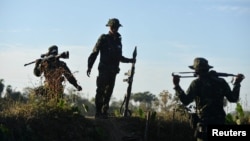Ethnic armies in Myanmar opposed to the country’s post-coup junta, and anti-junta resistance groups say they plan to increase military operations and guerrilla warfare in cities, despite difficulties in obtaining and weapons and ammunition, although some are coming in from neighboring Thailand.
Even before last February’s coup, Myanmar’s military was fighting the ethnic armies in the states of Kayin and Kachin in the east, bordering Thailand and China; in Rakhine state, on the Indian Ocean; and in the northern part of Shan state, bordering China. Now, junta forces have also been fighting resistance forces in Sagaing and Magway regions and Chin state in the northwestern part of the country, and in Kayah state, bordering Thailand.
Young people who have taken up arms in the face of a brutal military crackdown on anti-coup activities initially received military training from the ethnic armed groups, which had decades of experience fighting government forces, including those of the country’s previous junta. Now, many of these new resistance fighters have joined forces with ethnic armies, launching attacks on military outposts, police stations and administrative offices.
“At first we fought with handmade rifles, but now we can fight with real guns,” said Aung Thu, 26, serving with opposition forces in an area controlled by the Karen National Union, the country’s oldest ethnic organization. He spoke to VOA by phone February 4.
Meanwhile, KNU spokesman Padoh Saw Taw Nee indicated a change in his organization’s strategy.
"We have been fighting on the defensive for a long time. Now it is time to fight on the offensive to overthrow military dictators,” he told VOA February 4 by phone.
The KNU has not previously attacked military bases, but fought back against military attacks in KNU territory, Padoh Saw Taw Nee said. Now, he said, the KNU is planning to attack military bases in cooperation with the opposition’s People’s Defense Forces.
The other armed groups are attacking military outposts and infrastructure and ambushing military convoys.
The Chin National Front, another ethnic army, plans to launch more offensives against the military in coordination with the Chinland Joint Defense Committee – a coalition of People’s Defense Forces, which are under the control of the opposition National Unity Government, and locally based forces active in Chin and Sagaing.
The Karenni Nationalities Defense Force, another armed group, said on Facebook February 1 that Karenni People’s Defense Forces “have controlled almost all of the access roads into and out of state” so junta forces must deliver weapons and supplies by air.
“Although there are many PDFs and LDFs (local defense forces) across the Karenni state, all the groups unite under the command of the Karenni Army to launch military offensives,” said U Aung San Myint, a deputy secretary of Karenni National Progressive Party. He was referring to a Karenni armed group and to Kayah state, formerly known as Karenni state.
Similarly, the Kachin Independence Army, a powerful armed group in northern Myanmar, has joined forces with local defense forces and has been attacking military outposts and infrastructure in Kachin state since late January. On February 1, the force seized a junta military base, but fighting is still going on there as the junta has been trying to take the base back.
“I do not think there will be peace in the near future because the military keeps launching heavy offensives including air strikes in ethnic areas,” the Kachin Independence Organization spokesperson, Colonel Naw Bu, told VOA.
Urban guerrilla unit leaders say they mounted fewer operations after the November arrest of Phyo Zeyar Thaw, a former lawmaker from jailed opposition leader Aung San Suu Kyi’s National League for Democracy party, who has been accused of masterminding deadly attacks on regime targets in Yangon. However, urban guerilla forces conducted 24 explosive attacks on junta infrastructure and its affiliated property in 11 townships in the Yangon region on the February 1 coup anniversary.
Weapons, ammunition
“We could do nothing without enough weapons and ammunition,” said Soe Lin Naing, 20, a member of a Yangon guerrilla unit. Many groups are now working under the control of the NUG’s defense ministry, but they receive little in the way of arms and ammunition, and about 80% of that is funded by public donations from the Myanmar community inside the country and abroad.
People’s Defense Forces units fighting in conflict areas face an arms shortage. Members of a PDF unit in a district controlled by the Karen National Union said the imbalance of power in the conflict has become a barrier to defeating junta forces.
“Arms supplied by [the opposition National Unity Government] are very limited. Mostly we rely on individual donors having weapons,” said a PDF fighter who asked not to be named. Some of the weapons reportedly come from the black market in Mae Sot, Thailand, on the border.
“We have enough courage and manpower to kill junta forces, but we don’t have arms. Many comrades have died because of imbalance of power,” a member of a PDF unit in Sagaing told VOA.
The People's Soldiers Production Team, an NUG entity made up of soldiers who have defected, said February 10 that it could produce weapons and begin equipping PDF/LDF groups. It did not specify the type of weapon. It has said people can donate and have their name engraved on the gun for around $100 per gun.
Speaking to media outlet Myanmar Now January 30, Naing Htoo Aung, secretary of the NUG’s defense ministry, said at least $2 million is needed to arm each PDF chapter and cited difficulties in buying arms and transporting them to targeted areas. He said, though, that the NUG will be providing more weapons to PDF forces soon.





